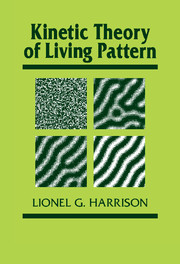Book contents
- Frontmatter
- Contents
- Preface
- Part I Macroscopics without mathematics
- 1 Introduction
- 2 Morphogen: one word for at least two concepts
- 3 Pictorial reasoning in kinetic theory of pattern and form
- 4 Structure, equilibrium, kinetics
- Part II Pattern-forming processes
- Part III Bringing experiment and theory together
- References
- Index
1 - Introduction
Published online by Cambridge University Press: 22 September 2009
- Frontmatter
- Contents
- Preface
- Part I Macroscopics without mathematics
- 1 Introduction
- 2 Morphogen: one word for at least two concepts
- 3 Pictorial reasoning in kinetic theory of pattern and form
- 4 Structure, equilibrium, kinetics
- Part II Pattern-forming processes
- Part III Bringing experiment and theory together
- References
- Index
Summary
Philosophy: lumping, splitting, abstraction, and reality
D'Arcy Thompson (1917) wrote that “the things which we see in the cell are less important than the actions which we recognize in the cell.” He expected that in the following few decades biology would advance in the direction of mathematical description of actions or processes. He, and most others at the time, believed that microscopy had reached the limits of its capacity to reveal microstructure, and few people believed that determination of the structure of genes was foreseeable. In the event, as everyone knows, developments that were not foreseen have made up a great part of the most spectacular advances in science over the past forty years. Meanwhile, those advances which Thompson anticipated have not occurred – to such an extent that Bonner (1961) omitted from his abridgement of Thompson's On Growth and Form the entire chapter containing the foregoing quotation. Was Thompson wrong?
My thesis is that Thompson erred only in regard to his expectation of the timing of an advance which would unite mathematical-physical science to biology in the same way that physics and chemistry had become united in the late nineteenth and early twentieth centuries. That unfulfilled union must take place, to my mind, in the twenty-first century if many of the problems of developmental biology, which today remain as mysterious to us as they were a hundred years ago, are ever to be solved.
- Type
- Chapter
- Information
- Kinetic Theory of Living Pattern , pp. 3 - 30Publisher: Cambridge University PressPrint publication year: 1993

